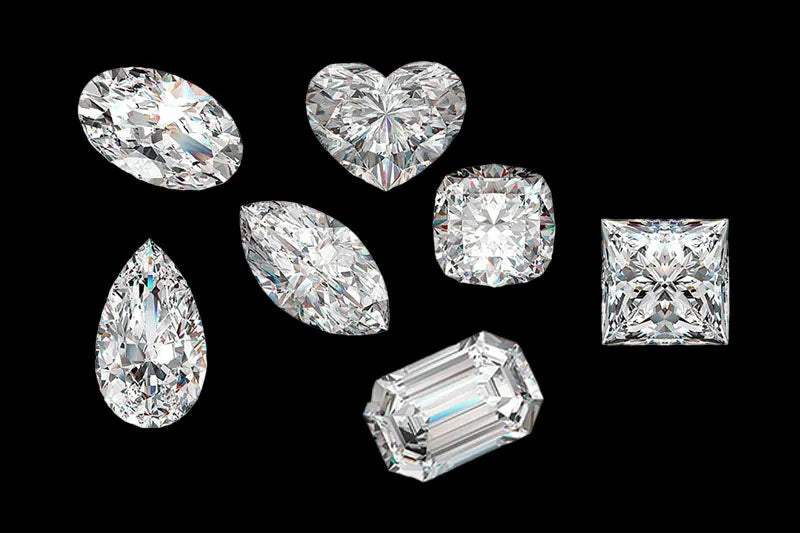
MOISSANITE: THE ULTIMATE DIAMOND ALTERNATIVE – A GUIDE TO BRILLIANCE, DURABILITY, AND VALUE
Share
Discover the beauty and brilliance of Moissanite, the popular diamond alternative. Learn about its origin, durability, comparison to diamonds, and why it’s the perfect choice for stunning, budget-friendly jewelry that lasts a lifetime.”
Moissanite: The Ultimate Guide to the Diamond Alternative
If you’re searching for a stunning, budget-friendly alternative to diamonds, Moissanite might be the gem for you. With its incredible brilliance, durability, and affordability, Moissanite has quickly become a popular choice for engagement rings and other fine jewelry. This comprehensive guide covers everything you need to know about Moissanite, from its origins and unique characteristics to how it compares with diamonds.
What is Moissanite?
Moissanite is a naturally occurring mineral known as silicon carbide. Discovered over a century ago by Nobel Prize-winning chemist Dr. Henri Moissan, Moissanite was first found in a meteor crater, leading many to call it a “gem from the stars.” However, naturally occurring Moissanite is incredibly rare. Today, almost all Moissanite used in jewelry is created in labs, making it an ethical, eco-friendly gemstone choice.

Moissanite vs. Diamond: How Do They Compare?
Moissanite is often compared to diamonds due to its similar appearance, but the two stones have some key differences. Let’s break down the main aspects where Moissanite and diamonds differ, helping you decide which stone best suits your needs.
1. Brilliance and Fire
One of the most notable qualities of Moissanite is its brilliance. In fact, Moissanite has a higher refractive index (2.65-2.69) than diamonds (2.42), which means it reflects more light and sparkles more intensely. Moissanite also exhibits a unique fire (the rainbow light effect) that some people find more vibrant than diamonds. This dazzling display of light is part of what makes Moissanite so captivating.
2. Durability
When it comes to durability, Moissanite ranks just below diamond. Diamonds are the hardest material on Earth, scoring a 10 on the Mohs scale of hardness, while Moissanite is close behind with a 9.25. This makes Moissanite an excellent choice for daily wear, as it’s highly resistant to scratching and chipping.
3. Color
Moissanite is available in various shades, from colorless to slightly warm tones. Most high-quality Moissanite used in jewelry today is colourless or near-colourless, giving it a look similar to diamonds. However, under certain lighting, some Moissanites may show a slight rainbow effect due to their unique refractive properties.
4. Affordability
One of the biggest advantages of Moissanite is its affordability. Moissanite costs a fraction of what diamonds do, making it a popular choice for those who want the look of a diamond without the hefty price tag. Generally, a Moissanite stone costs about 10-15% of a diamond of similar size and quality.
5. Ethical and Environmental Impact
Because Moissanite is lab-created, it’s a more environmentally friendly and ethical choice compared to diamonds, especially if you’re concerned about conflict-free sourcing. Lab-created Moissanite avoids the environmental issues associated with diamond mining and is a sustainable choice that doesn’t compromise on beauty or quality.
Why Choose Moissanite?
Moissanite is the ideal option for those seeking a dazzling, durable gemstone without the cost or ethical concerns of diamonds. It’s especially popular for engagement rings, but it’s equally suited for other types of jewelry, from earrings to pendants. With its lasting beauty and reasonable price, Moissanite allows you to own a large, brilliant stone that might be out of reach if you were choosing a diamond.
Caring for Moissanite Jewelry
One of Moissanite’s greatest advantages is its ease of care. To keep your Moissanite jewelry looking as brilliant as the day you bought it, follow these simple tips:
• Cleaning: Clean Moissanite using warm water, mild dish soap, and a soft toothbrush to remove dirt and oils.
• Storage: Store Moissanite separately from other jewelry to prevent scratching other gemstones.
• Professional Cleaning: For a deeper clean, consider having your Moissanite jewelry professionally cleaned once or twice a year.
Frequently Asked Questions about Moissanite
Is Moissanite a type of diamond?
No, Moissanite is a completely different mineral than diamond. While they may look similar, they have unique chemical compositions and properties.
Will Moissanite lose its sparkle over time?
No, Moissanite retains its brilliance and sparkle for a lifetime, making it a lasting choice for jewelry.
Can Moissanite pass a diamond tester?
Yes, Moissanite can sometimes pass as a diamond on standard diamond testers due to its thermal conductivity, which is similar to that of diamonds.
Final Thoughts
Moissanite is a stunning, practical alternative to diamonds, offering comparable brilliance and durability at a fraction of the cost. Whether you’re looking for an engagement ring or an elegant everyday piece, Moissanite provides the luxury and sparkle you desire without the environmental impact or price tag of traditional diamonds.
If you’re considering a beautiful, ethical gemstone that offers unparalleled value, Moissanite may be the perfect choice. Embrace the beauty of Moissanite and enjoy a gemstone that’s as brilliant and unique as you are.

